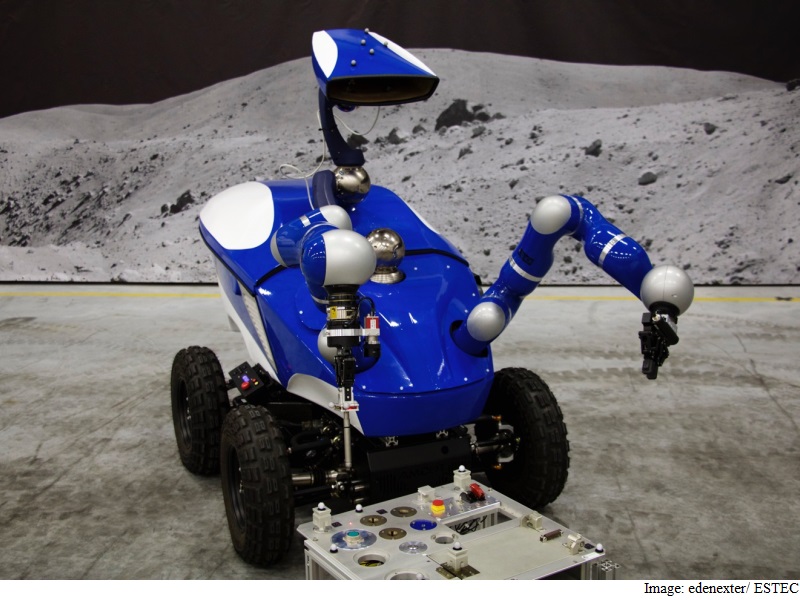- Home
- Science
- Science News
- One Small Step for Man as Astronaut Controls Robot From Space
One Small Step for Man as Astronaut Controls Robot From Space

European experts have pulled off a major advance that might one day help build new worlds in space after an astronaut in the International Station Station remotely guided a robot on Earth by feel.
Danish astronaut Andreas Mogensen performed the breath-taking experiment in which he placed a peg into a very tight hole on Monday under the careful control of the European Space Agency.
While orbiting some 400 kilometres (250 miles) above Earth, Mogensen took control of the Interact Centaur rover which has a pair of arms for delicate, high-precision work.
The blue-and-white fibreglass robot, which cost less than EUR 200,000 (roughly Rs. 1.5 crores) to build, also has a camera on its head which allows the controller to directly see the task it is performing.
But sight is not the most important sense in this project. It is touch.
In real-time, thanks to super swift signals bouncing off a dedicated complex system of satellites working in synchronisation, the astronaut manoeuvered the robot into place.
He then very slowly lowered a metal pin held by the robot into a tight hole in a task board with less than a sixth of a millimetre of wriggle room.
Using a joystick
For the first time - thanks to force-feedback technology - when the pin was not aligned correctly Mogensen felt it hit the sides of the hole via the joystick he was operating on the space station.
Cheers erupted when after several long nail-biting minutes the rover which slightly resembles Disney's WALL.E cartoon character dropped the pin successfully into place.
Scientists and engineers believe applications of this kind of tactile technology are huge allowing humans to guide robots in delicate tasks by feeling their way.
The technology will allow people "to project a human-like presence into the robots, to do human-like tasks on the surface" of a planet, Andre Schiele, head of ESA's Telerobotics and Haptics Laboratory, told AFP.
With space engineers hoping at some point to fly people to Mars, "we have to bring them back" which means before they first step foot on the planet "you would have to build an entire launch-platform on the planet."
Robots like the Centaur also affectionately dubbed the "blue bug" by some of its designers could be put in place first to do the building.
"There's going to be a need for a set-up, some building before a human even sets foot on the planet and for that we could send down robots and control them from a space station," said industrial designer Emiel den Exter.
The 18-month project was a collaboration between the European Space Agency (ESA) and students from Delft University of Technology.
"Even something like lacing your shoe is something you rely entirely on your tactile senses" for, Schiele told journalists gathered at the ESA headquarters in the Dutch town of Noordwijk.
Earthly uses
On Earth this cutting-edge technology known as haptics could also be used "everywhere where you basically don't want to send humans," said Schiele.
"Feeling" robots would have been useful to cap the 2010 Gulf of Mexico oil spill, or help seal the reactors at Japan's Fukushima nuclear power plant after the 2011 meltdown.
Professor Frans van der Helm, from Delft University's mechanical engineering unit, said one scheme was looking at using such robots to work in a massive nuclear fusion project in France.
Inside the costly, multipartner International Thermonuclear Experimental Reactor (ITER) - if it is built - "the heat will be about one million degrees," Van der Helm told AFP.
"So everything starts to deform" making it hard for robots to complete a task which they have been programmed for, he said.
In this case, telepresence technology would allow a human to feel their way through and fix a problem.
For 27-year-old Turkish student Doga Emirdag, who helped design the Centaur's exo-skeleton as part of his masters degree, Monday's demonstration was a big day.
"The robot as it is wouldn't go into space. But the technology being developed will go to space," he said with a broad smile.
Get your daily dose of tech news, reviews, and insights, in under 80 characters on Gadgets 360 Turbo. Connect with fellow tech lovers on our Forum. Follow us on X, Facebook, WhatsApp, Threads and Google News for instant updates. Catch all the action on our YouTube channel.
Related Stories
- Samsung Galaxy Unpacked 2025
- ChatGPT
- Redmi Note 14 Pro+
- iPhone 16
- Apple Vision Pro
- Oneplus 12
- OnePlus Nord CE 3 Lite 5G
- iPhone 13
- Xiaomi 14 Pro
- Oppo Find N3
- Tecno Spark Go (2023)
- Realme V30
- Best Phones Under 25000
- Samsung Galaxy S24 Series
- Cryptocurrency
- iQoo 12
- Samsung Galaxy S24 Ultra
- Giottus
- Samsung Galaxy Z Flip 5
- Apple 'Scary Fast'
- Housefull 5
- GoPro Hero 12 Black Review
- Invincible Season 2
- JioGlass
- HD Ready TV
- Laptop Under 50000
- Smartwatch Under 10000
- Latest Mobile Phones
- Compare Phones
- Realme P4x 5G
- OnePlus Ace 6T
- Nubia Flip 3
- Nubia Fold
- OPPO A6x 5G
- Samsung Galaxy Z TriFold
- Poco F8 Ultra
- Poco F8 Pro
- Asus ProArt P16
- MacBook Pro 14-inch (M5, 2025)
- Poco Pad M1
- Poco Pad X1
- Just Corseca Skywatch Pro
- Honor Watch X5
- Acerpure Nitro Z Series 100-inch QLED TV
- Samsung 43 Inch LED Ultra HD (4K) Smart TV (UA43UE81AFULXL)
- Asus ROG Ally
- Nintendo Switch Lite
- Haier 1.6 Ton 5 Star Inverter Split AC (HSU19G-MZAID5BN-INV)
- Haier 1.6 Ton 5 Star Inverter Split AC (HSU19G-MZAIM5BN-INV)

















